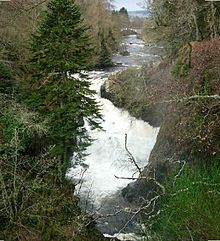Landscape facts for kids


A landscape is what you see when you look across an area of land. This includes natural features like landforms, plants (called flora), and animals (called fauna). It also includes things made by humans, such as buildings or farms.
The way a landscape looks can also depend on the light and weather. Sometimes, even objects inside buildings can be thought of as part of the landscape.
Contents
How Geology Shapes Landscapes
The way a landscape looks is mostly decided by the geology underneath it. Geology is the study of Earth's rocks and how they are formed. You can see this clearly in the Great Rift Valley in East Africa. Here, almost everything in the landscape is caused by Africa slowly pulling apart.
Even in places like Great Britain, where the Earth's crust is fairly stable, you can understand the whole landscape by knowing its geological past. For example, hard rocks often form hills, while softer rocks wear away to create valleys.
Where the Word 'Landscape' Comes From
The word "landscape" came into English from the Dutch language in the 1500s. At that time, Dutch artists were becoming very good at painting scenes of nature.
The Dutch word landschap first meant simply "a region" or "a piece of land." But later, it started to mean "a picture showing scenery on land." So, the word "landscape" became popular because of art!
Images for kids
-
An autumn landscape in Rybiniszki, Latvia. This watercolor painting is by Stanisław Masłowski, from 1902. It is kept at the National Museum in Warsaw, Poland.
-
A typical Dutch landscape in South Holland.
-
Medieval Ridge and Furrow patterns above Wood Stanway, Gloucestershire, England.
-
The Batad rice terraces in the Rice Terraces of the Philippine Cordilleras. This was the first place to be added to the UNESCO World Heritage List in the cultural landscape group in 1995.
-
Jichang Garden in Wuxi, China (built between 1506 and 1521).
-
Central Park in New York City, US. It was designed by Frederick Law Olmsted.
-
Damarri is a mythical being of the Djabugay language group. He is said to have turned into a mountain range. Here, he is seen lying on his back above the Barron River Gorge in north-east Australia.
-
The Blackmore Vale, a main setting for Thomas Hardy's novel Tess of the d'Urbervilles. This view shows Hambledon Hill looking towards Stourton Tower.
-
The Tetons and the Snake River (1942), a photograph by Ansel Adams.
-
Thomas Cole "The Course of Empire The Arcadian or Pastoral State", US, 1836.
-
Raphael, Madonna in the Meadow (1505 - 1506).
-
Albert Bierstadt, The Matterhorn (around 1867).
-
Vincent van Gogh, Wheat Fields at Auvers Under Clouded Sky (1890).
-
Pablo Picasso, 1908, Paysage aux deux figures (Landscape with Two Figures).
-
Paul Nash, Wire (1918).
-
Carl Brandt: "Åreskutan, landscape", 1921 (Sweden).
-
Emily Carr, Odds and Ends, 1939 (British Columbia, Canada).
See also
 In Spanish: Paisaje para niños
In Spanish: Paisaje para niños























